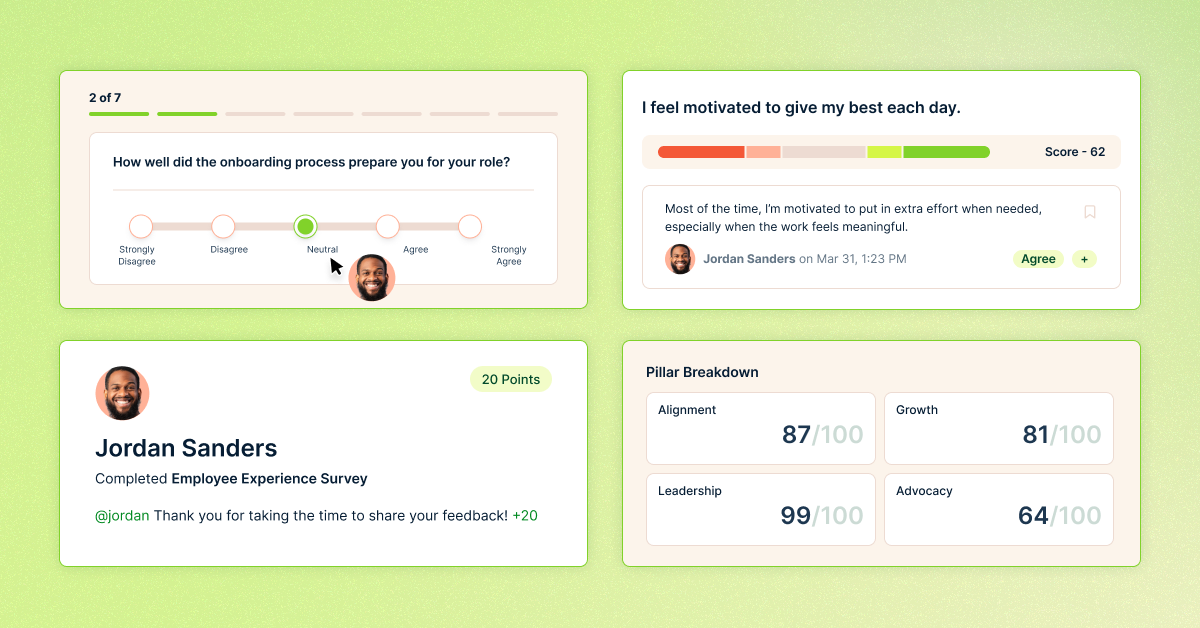Creating a Workplace Where Open Communication Thrives

Here's the TL;DR
When employees are left in the dark, confusion and distrust follow. This article explores how open communication—defined as a strategic, two-way flow of honest, timely, and accessible information—can build trust, boost performance, and improve engagement. In fact, 81% of workers prefer open communication over great perks, yet only 7% feel it’s happening in their organizations. Transparency isn’t about oversharing—it’s about clarity, alignment, and psychological safety.
Benefits of Open Communication:
- 2.8x more likely employee engagement
- Increased retention and collaboration
- Better alignment on goals
- Stronger team trust and morale
Barriers to Openness:
- Fear of retaliation or “sounding stupid”
- Lack of clear communication channels
- Leadership not modeling transparency
- Remote/hybrid disconnects in feedback
Strategies to Build an Open Culture:
- Train leaders to share openly and request feedback
- Create psychological safety through recognition and rituals
- Establish clear policies and communication channels
- Use tools like Slack, email, eNPS surveys, and feedback software
- Measure impact with audits, engagement surveys, and communication metrics
Have you ever heard the phrase, “I wish leadership would just tell us what’s going on?” When employees are confused or left in the dark about what’s happening, it can create uncertainty and fear.
Developing a culture where communication is open and transparent can be reassuring to employees and drive performance. In this article, we’ll dive into different strategies on how to build and maintain an open communication culture.
Understanding Open Communication in the Workplace
Employees are longing to work for a company that emphasizes the importance of open communication. In a recent study, 81% of respondents said they would rather join a company that values “open communication” than great perks. But what does “open communication” actually mean? It doesn’t mean telling employees about everything happening at work or oversharing important, sensitive details.
What defines open communication?
Open communication is about creating a strategic flow of information that fosters trust and alignment within the organization. One of the foundational pieces of open communication is that it’s a two-way street – it’s not just a top-down info dump. For open communication to work, it needs to be accessible, timely, and an honest sharing of information. Sadly, only 7% of employees agree that communication in their organization is timely and open.
For example, a company rolls out a new PTO policy to employees. To roll this out, they’ve decided to hold a company-wide town hall to explain it to employees. During this town hall, they’ve provided a handout for employees, a link to the new policy on their intranet going into greater detail, and a new Slack channel where employees can ask questions about the new policy.
Benefits of transparent workplace communication
Both leaders and workers understand the important, yet delicate, relationship between transparency and trust. Deloitte found that 86% of workers and 74% of leaders surveyed said that increasing trust and transparency was very or critically important.
Having transparent communication can have a tangible effect on your organization. It can increase:
- Employee engagement - Employees are 2.8 times more likely to be engaged, which can translate to a 23% increase in profits.
- Retention
- Team collaboration and problem solving
- Alignment with team and company goals
Common barriers to open communication
While it would be amazing to wave a magic wand and transform your company into one that thrives at open communication, some holdups might cause you to struggle implementing this. As you strive to develop a culture of open communication, your employees might not fully buy in (at least initially) because:
- Fear of retaliation: Nearly 43% of workers fear retaliation if they speak up about workplace issues.
- Fear of looking uninformed: Employees are hesitant to ask questions because they fear appearing “uninformed” or “stupid.”
- Lack of clear channels to ask questions: 33% of employees felt that poor and closed internal communication plans hurt their morale.
- Leadership isn’t modeling transparency: Leadership doesn’t practice what they’re preaching. Instead of building up transparency, this can have the opposite effect and ruin a company’s culture.
- Lost in translation - in-office vs hybrid vs remote work: Nearly 60% of managers believe that hybrid and remote employees are missing out on feedback and development.
Building the Foundation for Open Communication
For any organization to create a culture of open communication, it will start with leadership. You can’t just tell people to “speak up” and expect it to happen. Employees will model what they see from their leaders, and see if they are held to the same standards
Leadership's role in fostering transparency
Your leaders are, well, leaders. They set the tone in your organization. Employees watch them to understand how to act, which behaviors are acceptable, important, and worth following. Leaders who support their teams have 3.4 times more engaged workers than those who don’t. Sadly, though, only about 35% of leaders play an active role in communicating.
Leaders can create opportunities to showcase transparency through sharing failures, asking for feedback, and admitting gaps in knowledge. For example, they could hold a town hall meeting after a semi-annual engagement survey, where you discuss what the company is doing well and areas the company can improve. Doing this allows the employees to feel that their feedback is heard, and that the company is going to act and change.
Creating psychological safety
Nearly 99% of companies encourage a culture of open and transparent communication. Psychological safety is the foundation on which open communication is built. If people don’t feel safe to share their thoughts or feelings because of the fear of retaliation, then they won’t have the courage to speak up.
While it won’t happen all at once, organizations and leaders can:
- Publicly recognize when someone raises a tough issue or problem that the team needs to solve
- Hold regular “debriefing” sessions about what went well and what you should have done differently
- Regularly train employees and managers on strategies around psychological safety
- Build mechanisms or rituals that make it easy for frontline employees to raise issues to senior leadership
- Ask others for their opinions and act on them
Establishing communication channels
Between Slack, email, 1:1s, town halls, and a variety of other channels, you’ll need to determine what channels you want to use to communicate. It can be difficult to decide which channels are the most important for your employees. Should that important announcement ONLY be an email, or should it be an email AND a Slack? Internal communication tools allow for multi-channel distribution so you can quickly distribute important communication to whichever channel your employees spend their time in.
While over 70% of leaders say that email is the best way to communicate, you’ll want to consider the dynamics of your team. Are they primarily in-office, remote, or hybrid? What are the demographics of your team? Are they primarily Gen-X, Millennials, Gen Z, etc?
Once you’ve determined the channels you plan on using, reinforce that with your employees. Communicate to them the purpose of each channel and when to use them. For example, Slack is great for quick benefits questions. Email is for discussing performance issues.
Practical Strategies for Implementing Open Communication
Open communication doesn’t happen by chance. It results from a detailed Internal communications strategy, following through, and implementing practices. You have to proactively establish policies and procedures and be consistent in using them.
Developing clear communication policies
Gallagher found that 60% of companies do not have a long-term internal communications strategy. Developing clear communication policies provides a foundation of transparency for your employees. It also serves as a place where employees can know how, when, and what types of information you’ll be communicating. This can help prevent misunderstandings, missed announcements, and provide a permanent place to get feedback.
Setting up feedback mechanisms
While most organizations focus on top-down communications, it’s crucial for companies to establish feedback channels to learn what is affecting employees. This allows your employees to give their opinions, concerns, and suggestions on how to improve the company. Doing so helps employees feel valued and heard.
Employees who feel like their voice is heard are 4.6 times more likely to perform better than their counterparts. Feedback can come in different ways. Depending on the size of your company, you could try anything from:
- Holding 1:1 feedback sessions or group feedback sessions with employees
- Asking for feedback in a town hall
- Suggestion box
- Implementing an eNPS or Pulse Survey
- Semi-annual engagement surveys
Lastly, as you gather feedback, make sure that you do two things:
- Ensure anonymity - Allow employees to have the option of leaving feedback anonymously. Employees are more likely to be open to leaving feedback if they know that there won’t be any retaliation from the organization.
- Act on the feedback - Acting on the feedback and communicating it out, let’s employees see that their voice was heard and their feedback was valuable.
Creating regular communication touchpoints
To help reinforce your open communication culture, you’ll want to establish regular touchpoints with your employees. The frequency of these touchpoints will depend on the severity of the issues facing your organization and the pain your employees are feeling. If it’s on a team level, it might be good to have a weekly team stand-up. If it’s something that affects the entire company, it might need to be addressed each month during an all-hands meeting.
Tools and Technologies for Enhanced Communication
Now that you have the strategy, it’s time to act on it. A small business may be able to handle 1:1 communications with each employee, but as your employee count grows, that becomes inefficient and impractical. The right internal communications tools can easily create beautiful announcements, amplify them through multiple channels, and allow you to measure who’s seen key announcements.
Collaboration platforms
For corporate employees, collaboration platforms like Slack and Microsoft Teams aren’t just for chatting, they’re the lifeblood of an organization. Nearly 80% of workers are currently using some sort of collaboration tool. These tools allow team members to connect with each other near-instantaneously, share ideas, and keep the team aligned.
Even though the majority of workers use some type of collaboration tool, there’s still confusion about how to use them. Create a “best practices” guide for using these tools and detail how employees are expected to use them. For example:
- Work out in public - avoid using DM’s when discussing project statuses so that others can self-serve and see where things are at.
- Async vs Real-time - When doing async updates, provide a video recording so it’s easy for people to follow what you need from them.
Communication software
While collaboration platforms allow employees to work horizontally (peer-to-peer), communications software allows organizations to work top-down. This method allows for companies to streamline important announcements into key channels so that they can make sure that employees are on the same page.
Although email is the most common communication channel used by companies. It can lack creativity and follow-through. Communication software allows companies to create visually appealing announcements instead of just plain-text emails. They can also help companies get in front of their employees through multi-channel distribution, and track which employees have seen important announcements so information doesn’t slip through the cracks.
Feedback tools
Another crucial type of tool for your culture stack is a feedback tool. Zippia found that companies that invest in regular employee feedback have nearly 15% lower turnover than organizations that don’t gather feedback. These tools allow you to gather real-time feedback from employees on what the culture is like at your company.
Generally, with feedback tools, you’ll want to look for tools where you can:
- Control the frequency of what you send out
- Provides actionable data
- Gather quick, anonymous feedback from employees
- Customizable survey types
- Measure employee sentiment
Measuring Communication Effectiveness
Peter Drucker once said, “What gets measured gets improved.” If you want your communication to improve, you’ll need to measure it, refine it, and optimize it - just like any other business function. Even though companies understand the importance of communication metrics, sadly, only 54% of companies report that they effectively measure their communication strategies.
Key metrics to track
One great thing about an internal communication platform is that they generally have built-in functionality to track employees who have seen it and interacted with your announcement.
So, what metrics are most important to track? Well, it depends. Each channel will have different metrics that you’ll want to track. For example:
Employee satisfaction surveys
Communication isn’t just about pushing information out, it’s about knowing how it’s received. Regular eNPS, pulse, and engagement surveys allow you to measure how employees are feeling and how culture is changing within your organization.
These surveys allow you to turn your “gut feelings” into quantitative data, which you can measure and track the change in data. You’ll be able to tie back changes in scores to when you rolled out your HR initiatives. HR doesn’t have to be a cost center, but can be a strategic business function.
Regular communication audits
Carve out time for regular communication audits so that you can adjust what’s working and what’s not working. Audits help you close the perception gap. While you may think that you’re communicating clearly, an audit may reveal holes in your plan that still need to be fixed. Also, doing this helps employees see that you’re continuing to listen to them and applying feedback from them on what’s working.
Overcoming Communication Challenges
Even the best-laid plans can have flaws. Remote work, cultural differences, conflict, and poor technology adoption can create hurdles in creating an open communication culture.
Remote work considerations
Over the past 12 years, there’s been a nearly 160% increase in the number of remote workers. While 75% of remote workers report higher work-life balance, between 30-40% of remote workers report feeling less connected to their colleagues compared to working in an office.
To overcome this, remote teams need to over-communicate. That means creating structured touchpoints for teams to check in with each other. Create rituals like holding regular video calls, digital shoutouts, or virtual coffee chats.
Cross-cultural communication
Diverse teams can make your team stronger, but also require learning different customs and cultures. Other cultures approach verbal and non-verbal communication differently. What feels “clear and candid” in one context may come across as “blunt and disrespectful” in another.
Conflict resolution strategies
Even in the best of companies, conflict happens. Poor communication leads to conflict, and when conflict isn’t handled correctly, it will lead to resentment, silence, and fractured relationships. When it’s handled well, it can be a catalyst for innovation, growth, and deeper collaboration.
Where Strong Cultures Start
Open communication isn’t just a set of policies or tools — it’s a daily practice. It’s the foundation of trust, alignment, and belonging. When employees feel informed, heard, and safe to speak up, they don’t just do their jobs — they show up fully. They collaborate better. They stay longer. And they care more.
Whether you’re leading a small team or shaping culture across an entire organization, the path to transparency starts with intention. Build the systems. Model the behavior. Measure the impact. And keep going — because strong cultures aren’t built in announcements or town halls. They’re built in the moments where people feel seen, heard, and included. Every day.















